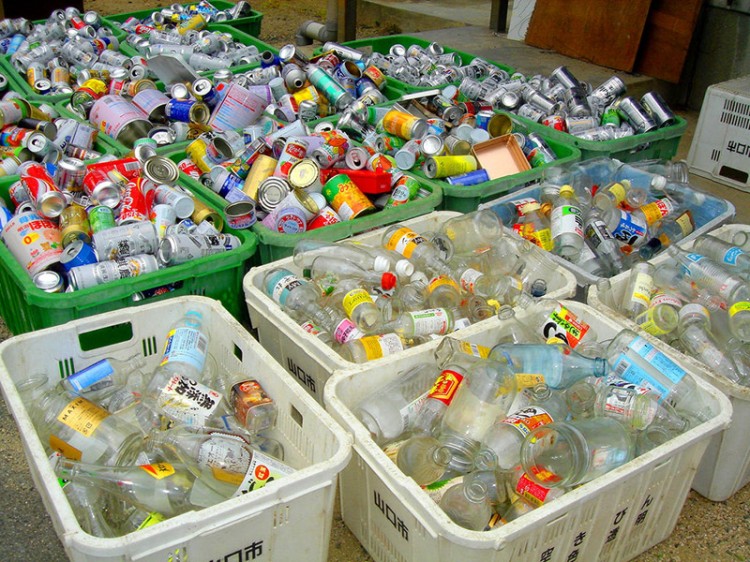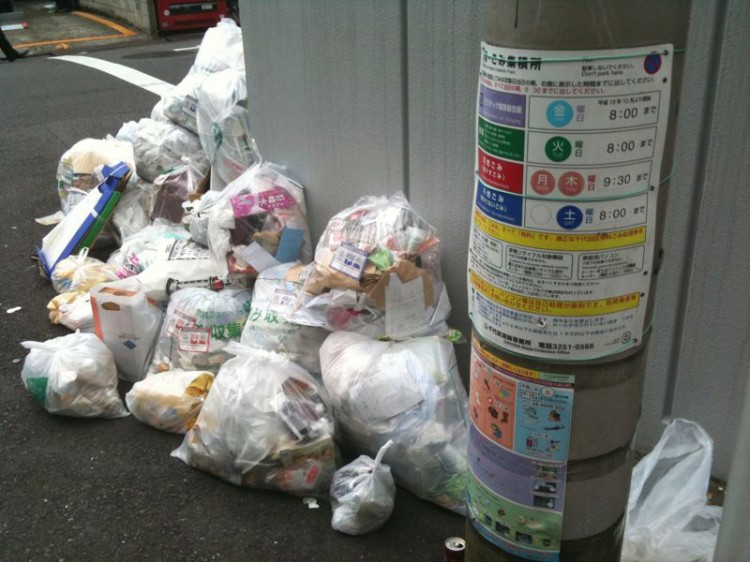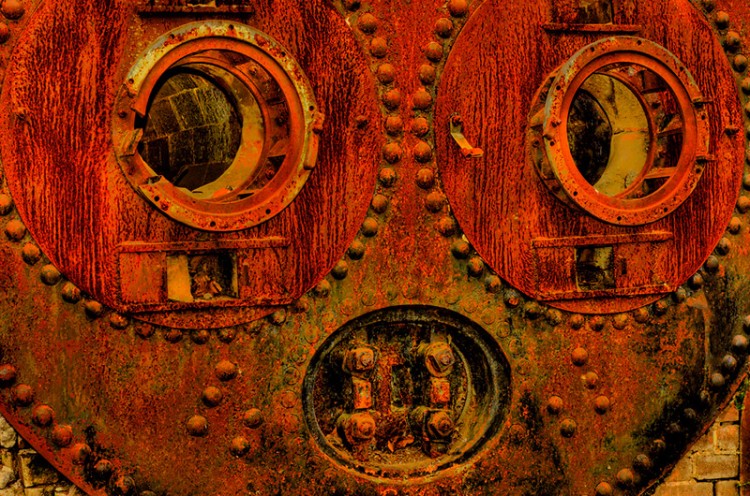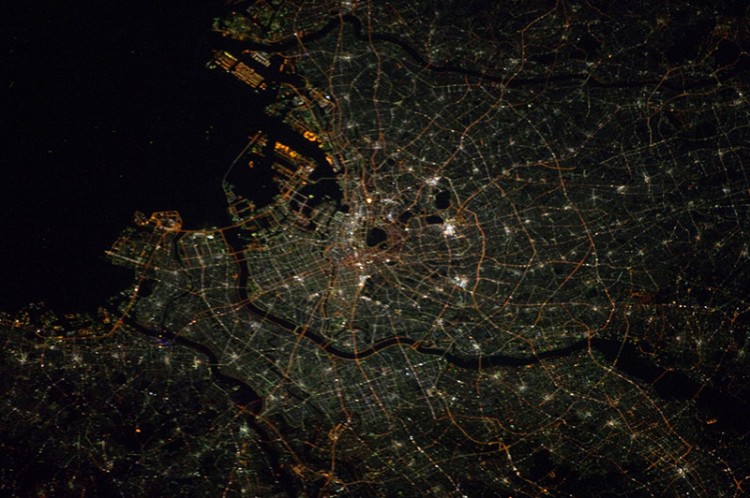If you take a walk in a city in Japan, you might notice something. Where are all the rubbish bins!? Seriously, you've been carrying this empty onigiri wrapper around for an hour now and you just want, no need, to find a bin! If you do find one of these rare public trashcans, you'll notice that it isn't just one, but many different bins grouped together. You may have been able to find them, but now you have to work out if this onigiri wrapper paper or plastic.
Let's Talk Trash.

If you have ever lived in Japan, you've probably discovered that once you are responsible for your household's garbage, things get a lot more complicated. Have you been faced with the challenge of sorting and cleaning your garbage meticulously, making sure to put it out on the right day in the right colored bag, or suffered the shame of having it returned to you?
After these experiences it might seem like Japan is an incredibly clean and eco-friendly country that is super keen on recycling. However, things are even more complex if we look a little deeper.
Sort It Out!

If you have moved to Japan, one of the first things you'll need to do is get hold of your town's gomi guide. Gomi ごみ (sometimes written ゴミ) is the Japanese word for garbage. Here's an example guide from Niihama City. It is forty-two pages long! That kind of length isn't unusual either. As the Tokyo International Communication Committee says in its garbage guide, "Trash-related issues could easily become a cause of trouble with your neighbors. To establish a comfortable life for both you and others in the community, it is important to follow local rules for trash collection."
There's no simple way to describe Japan's rubbish sorting system. Waste disposal is carried out at the municipal level. That means that each city, town, and district has a completely different system. Even Tokyo's twenty-three wards have different systems.
So even if you've mastered one system, that doesn't help you all that much if you move somewhere else. For example, my town's garbage was sorted into burnable (red bags), non-burnable (blue bags), paper, plastic, PET bottles, cans, styrofoam, newspapers, cartons, unbroken glass, and batteries (white bags, with different collection days). That was a fairly relaxed system, comparatively. I knew people who had to sort out their namagomi 生ごみ (food waste) from their burnables and their envelopes from their paper.
Some types were collected every week, some every fortnight. Other types were collected anywhere from once a month to once a year (I kicked myself the year I missed the one day for battery collection). Over sized garbage was collected twice a year and you had to buy a special sticker to pay for disposal. You also had to buy specific garbage bags that were only usable in your town. You couldn't just put your burnable garbage in any red bag, it had to be a special, approved red bag. If you messed up, you risked having your rubbish returned to you with a sticker of shame, so that all your neighbors could see how you failed.
Now I was fairly lucky, my town was by no means as strict as some. There were still some tricky moments, especially when trying to sort packaging that was half paper and half plastic, or working out what to do with something that wasn't on my garbage sorting chart (empty toothpaste tubes, huh?!). The strangest thing about my garbage system was that I had to put my trash in a cage designed to keep bears out. It was a bit battered and one side had been replaced with fiberboard after a particularly persistent bear took interest. In other areas, trash is put out under nets to keep crows away.
Unfortunately, not everyone is as lucky as I was and there are some true trash horror stories out there. The town of Kakimatsu in Shikoku has 44 different garbage categories. A New York Times article details how the incredibly strict garbage sorting system enforced by some locals affected residents, from a woman who was shamed for using a thin pen to write her identification number on her bag, to a non-compliant couple who were evicted from their apartment under pressure from a local garbage sorting enforcer. This might be at the extreme end of the spectrum, but rubbish sorting can be a real problem, especially for foreigners just arriving in Japan.
Getting all of this done may be inconvenient, but it's certainly not impossible. For people living in small apartments it can be hard to find enough space to fit in all the rubbish bins they need to separate their trash, but it will be even more of an inconvenience if you don't bother to sort it out at all.
Why Is Sorting So Strict?

You might think that you are being made to do all this trash sorting as some kind of punishment, but there are some pretty important reasons behind it. Japan has a set of specific challenges when it comes to dealing with its waste. The biggest of these is lack of land suitable for landfill. In the 1960s it became clear that, with it's rising population, Japan would have to find a solution for its garbage or sink under the weight of its trash.
According to Waste Atlas each person in Japan produces an average of 356.2kg of waste per year and as a whole, Japan generates 45,360,000 tons of municipal waste per year, ranking 8th in the world. Unlike larger countries like the United States and China, there simply isn't the space to bury it all. Japan had to find another solution.
Where Does It All Go?

After all that waste has been sorted and collected, where does is all go? You might think that you are sorting your waste so that it can be more easily recycled. This is a fairly common misconception and one that I shared when I first arrived in Japan.
However, a happy, new recycled life is by no means the final destination for most of those papers you've torn into the correct sizes and plastic wrappers you've sorted. When it comes to its recycling rate, Japan (20.8%) lags behind other industrialized nations that also face problems with lack of space, such as the Netherlands (51%) and the UK (39%). No, your rubbish is probably going to be burned.
If you hear the words "fluidized bed" in relation to Japan, you might think you're reading an article about Love Hotels. Sorry to disappoint, but at least fluidized bed combustion is pretty exciting. It is a very efficient way of burning materials that don't normally burn easily. Your carefully sorted rubbish will be suspended in a hot, bubbling bed of ash and other particulates as jets of air are blown through it. Apparently the "fast and intimate mixing of gas and solids promotes rapid heat transfer and chemical reactions within the bed." Who ever said garbage disposal wasn't sexy?
All joking aside, this thermal treatment of municipal solid waste does have some advantages over other forms of incineration. It is cheaper, takes up less space, and produces fewer nitrogen oxides and less sulphur dioxide. One of them was even built near Shibuya station in 2001. It can also be used as part of a Waste to Energy system, using the resultant heat to create power. Given Japan's problems with producing electricity this is certainly a big advantage. Although this method might not have as clean an image as recycling, it does suit Japan. So perhaps it is not a surprise that Japan is the biggest user of this type of technology in the world. In the hierarchy of waste management (yes, that's a real thing) this kind of Waste to Energy disposal method ranks below recycling and composting, but above all kinds of landfill. In contrast, the United States uses landfill to deal with almost exactly the same percentage (69%) of its waste as Japan uses incineration. Japan also exports these technologies to countries like China, Thailand, and Singapore. While it may not be as glamorous or as green as complete recycling, Waste to Energy disposal could be the solution to some of the problems we are facing all around the world.
Returning To Recycling

What happens to that 20.8% that is recycled? One success story can be found with PET bottles. PET stands for polyethylene terephthalate and these are used to make the drink bottles you'll find in vending machines and convenience stores all over Japan. After you've downed your delicious oolong cha or lychee and salt beverage, be sure to pop that bottle into a PET bottle bin. Japanese companies have increased the percentage of used PET bottle plastic that can be used to make new PET bottles. PET bottles can be dissolved and filtered at high temperatures, producing a pure resin that can be turned back into new PET bottles. This has reduced Japan's need for petroleum-derived resources for making PET bottles by 90%.
PET bottles that do not undergo this filtration process can also be turned into other things. A fiber can be spun from recycled PET bottles, which can then be made into clothes, bags, carpets, and doggy raincoats.
Since PET bottle recycling is one of Japan's recycling success stories, perhaps it isn't surprising that PET bottle bins are usually the most common bins you'll see. They will often be outside convenience stores or next to vending machines. They typically have a round hole and some have a second smaller hole for bottle caps. Make sure you don't throw any other kind of garbage in there though. Think of the poor person who will have to sort it out later.
Not Enough Land For Landfill? Use Landfill To Make More Land!

Japan has one more solution for dealing with its trash. If there isn't enough land to bury the trash, why not just make more land with the trash? You might be familiar with land reclamation (also called land fill, but not landfill, just to be confusing) from seeing pictures of the The Palm Islands, built off Dubai in the United Arab Emirates. Well Japan has also used this technology of filling in an area of water with heavy rock, cement, dirt, and garbage to make new land, though not in quite such fancy shapes. The Chūbu Centrair International Airport near Nagoya and Kansai International Airport are both built on artificial islands. In Tokyo, where land prices are astronomical, 249 square kilometres (96 square miles) of land has been reclaimed in Tokyo Bay through land fill.
Your old onigiri wrapper will probably be burned in a fluidized bed, but there's a chance it will become a part of Japan's newest island. So when you are struggling to sort your moeru gomi from your moenai gomi or your sodai gomi from your shigen gomi, remember that these simple actions are helping Japan.
Mottainai!

There is one more component to waste management in Japan that we haven't looked at yet. Why is all this waste here in the first place? If you have ever bought something in Japan you've probably noticed how much packaging there is. Layers upon layers of plastic and cardboard. Bags within bags. Plenty has been written on the cultural aspects of Japan's obsession with wrapping. Taking your own "eco-bag" might help a little, but the goods themselves are still over packaged. It will be interesting to see if cries of mottainai もったいない! over all this waste will ever change the situation on a larger scale. Mottainai is a very old Japanese word that can loosely be translated as "What a waste!" or "waste not, want not."
While Japan might be good at dealing with wastefulness in some ways, in others it still produces huge amounts of waste that have to be dealt with. There have been some projects encouraging people to reduce their waste production, such as using, "My Hashi" personal chopsticks, rather than disposable ones, or rediscovering old furoshiki wrapping traditions to cut down on packaging. Will Japan listen to its own word "mottainai," or will it develop newer and more efficient incineration technologies to dispose of its over packaging? We'll have to wait and see what the future bins of Japan have in store for us.
